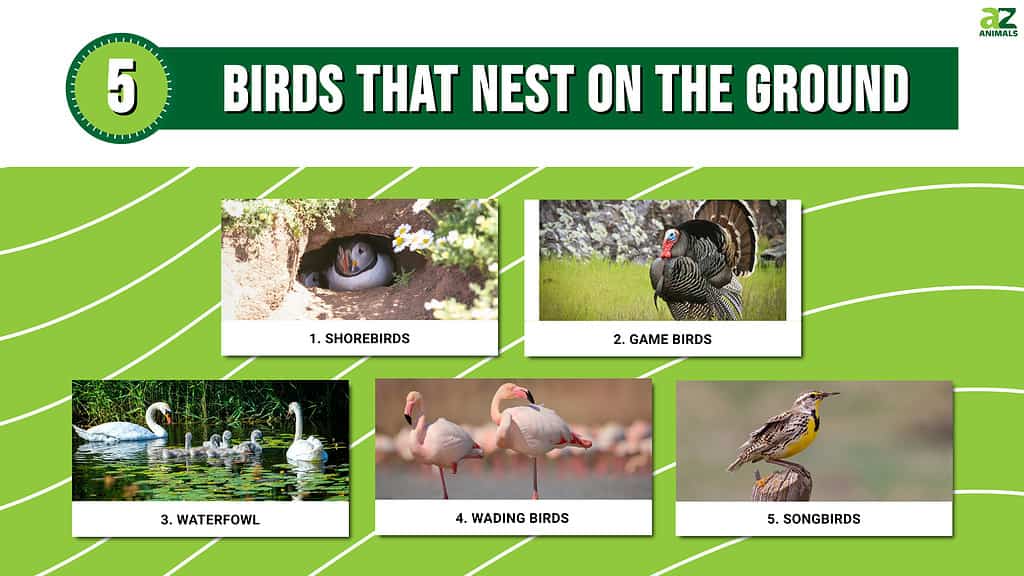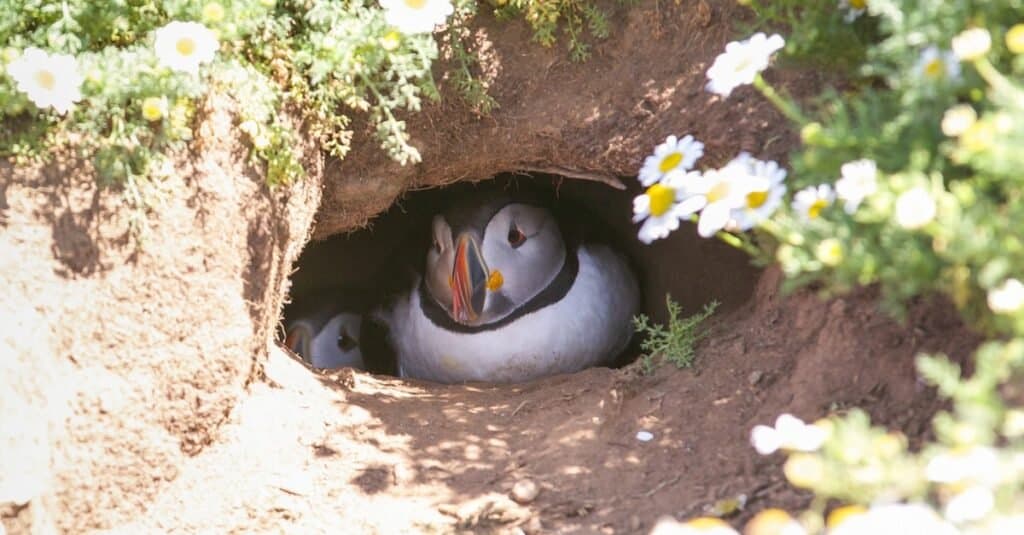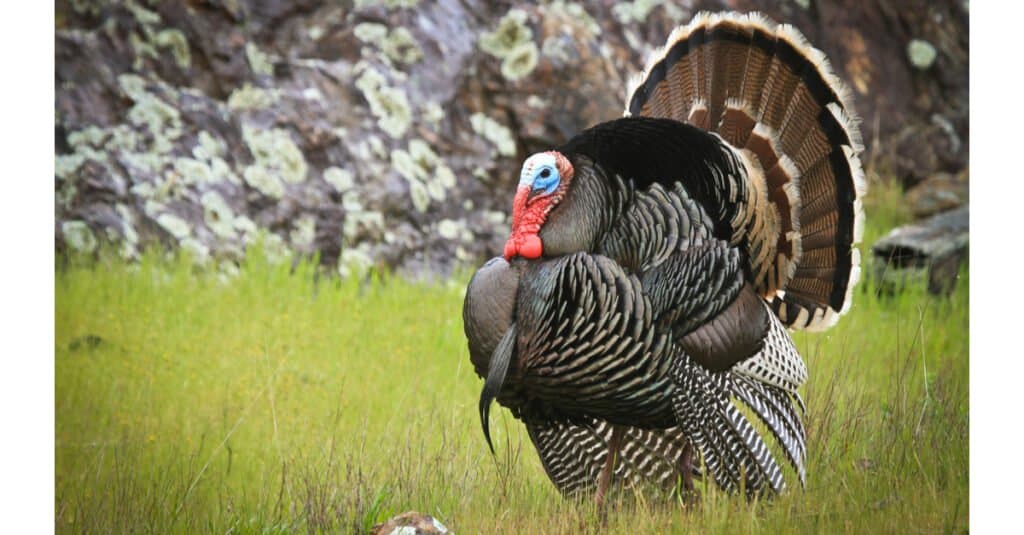When you think of a bird’s nest, where do you imagine the nest is located? Most people imagine a cup nest in a tree, which is understandable. At some point or other, we’ve all seen a bird’s nest in a tree, and our media enforces this image in TV and movies. The reason behind building a nest in a tree is well-founded. From tiny songbirds to huge eagles, lots of birds build their nests in trees to protect themselves from predators. However, some birds buck this trend. These birds may build flat platforms, scrape, or burrow nests on or in the ground to hold their eggs. There are many birds that nest on the ground, and it would be difficult to name them all. That said, it’s a much easier task to divide them into categories.

In this article, we’ll look at 5 categories of birds that nest on the ground. Furthermore, we’ll provide specific examples of bird species in each category that exhibit this behavior. Here are the five groups of birds that build their nests on the ground.
#5: Shorebirds

The Atlantic puffin builds its nest in the ground or inside the crevice of a rock.
©iStock.com/Henfaes
The term shorebirds refers to a group of birds that live near coastal wetlands and shorelines. While sometimes used synonymously with wading birds, shorebirds include non-wading birds that live near coasts and mudflats. Shorebirds include avocets, terns, gulls, sandpipers, stilts, plovers, puffins, and penguins. Commonly found near rocky or sandy shorelines and shallow waters, most shorebirds migrate in the winter to more temperate climates. Some of the birds that migrate the longest come from the shorebird category. These birds summer in Arctic or sub-Arctic habitats, and summer in tropical environments on the other side of the world. Most shorebirds that nest on the ground do so because trees grow sparsely in their natural habitats. As a result, they adapted to building nests on rocky or sandy patches of ground.
American avocets build their nests in large colonies that may constitute hundreds of birds. They construct their nests near water, particularly on islands with little vegetation. The American avocet scratches out a scrape nest and lines it with feathers, rocks, grass, and other small objects. To prevent their eggs from overheating, adults may wet their bodies while incubating to cool off their eggs. The Atlantic puffin is another bird that nests on the ground, or rather in the ground. They typically dig a burrow nest in the dirt or make a nest inside a crevice between rocks. The nest is then lined with grass and twigs to provide insulation and protection for the eggs. Unlike most birds, puffins may reuse the same nest year after year rather than making a new one.
#4: Game Birds

Turkeys construct their nests in woodlands near clearings or roads.
©Tory Kallman/Shutterstock.com
Game birds include any number of birds traditionally hunting for food by humans. Species included in the game birds category include quail, partridge, pheasants, turkeys, grouse, and guineafowl. Almost all game birds nest on the ground because most do not fly well enough to build nests in trees. Most game birds do not migrate and live year-round in their breeding habitats. While many game birds construct their nests inside shelters, others build theirs out in the open. Furthermore, due to their use in sport hunting, some game birds now live on managed estates. Groundskeepers ensure that enough game birds breed to ensure their population remains stable for continued hunting. There also exists a substantial commercial industry that raises game birds for mass consumption. That said, many game birds continue to live in the wild.
Wild turkeys mostly build their nests in woodland habitats. However, they tend to construct their nests near treelines abutting roads, fields, or other clearings. The nests are made in shallow depressions in the ground and lined with twigs and arboreal vegetation. They locate their nests in areas with plenty of overhead cover, such as a thicket or beneath low-hanging branches. Guineafowl also build their nests on the ground. Their natural instinct is to choose a secluded location for their nest, including areas with tall grass or fallen branches. That said, as guineafowl live in flocks, multiple females may lay eggs in the same nest. A single nest may hold up to 50 eggs at a time and will continue to grow until one of the females decides to brood the clutch.
#3: Waterfowl

Mute swans construct large cup nests that measure around 6 feet long.
©Sergei25/Shutterstock.com
The term waterfowl refers to a number of species of aquatic birds, specifically swimming game birds. Species that fall under the waterfowl label include ducks, geese, and swans. Most waterfowl live near wetlands and count among birds that nest on the ground. They tend to build their nests near water, as their hatchlings are precocial. This means that shortly after they hatch, waterfowl young can move about and take care of themselves. Therefore, waterfowl have no biological incentive to build their nests up in trees or at high elevations to protect their young from predators. Many species migrate after the breeding season to warmer climates and will return in spring once the weather changes.
Mute swans take a unique approach when they build their nests. Many choose to build their nests on islands in the middle of a lake or close to its edge. Mute swans build large cup nests, with the largest measuring up to 6 feet long and 1.5 to 2 feet high. The male swan will construct the nest out of vegetation and feathers. However, if it’s not up to the female’s standards, she may make him start over. Unlike the mute swan, the American wigeon chooses to locate its nest far away from water. It’s not uncommon to find an American wigeon nest more than 100 feet from the edge of the nearest body of water. To protect their eggs, they hide their nests in areas with tall weeds and grasses. The female will make a scrape nest, and then line it with grasses, aquatic vegetation, and feathers.
#2: Wading Birds

Flamingos build nests made out of mud shaped into mounds.
©Ondrej Prosicky/Shutterstock.com
Sometimes lumped together with shorebirds, wading birds include long-legged birds that primarily live near wetland habitats. Wading birds include flamingos, spoonbills, storks, ibises, cranes, herons, and rails. Most wading birds that nest on the ground do so near marshes, lakes, or swamps. That said, a number of wading birds choose to build their nests above water, including wood storks and great blue herons. Like shorebirds and waterfowl, most wading birds migrate during the winter to more temperate climates. However, some will remain in their breeding range year-round.
Flamingos construct unique nests made out of mud, stones, dry grasses, and feathers. Both the male and female will work together to build the nest. With their bills, they will drag mud and objects into a mound, then use their feet to shape the nest. The whole process can take up to six weeks. By the time they finish, the mound may stand almost 12 inches off the ground. Meanwhile, sandhill cranes build flat platforms nests made out of twigs, grasses, branches, and weeds. The female is ultimately responsible for building the nest, although the male will help gather materials. Sandhill crane nests can measure four to five feet long by the time the female finishes constructing the platform. However, the female will likely continue to add materials while incubating her eggs.
#1: Songbirds

Western meadowlarks occasionally weave together protect covers for their nests.
©iStock.com/Gary Gray
Songbirds include any one of over 5000 different species of perching birds. While most songbirds nest in trees, there are some birds that nest on the ground. These include hermit thrushes, bobolinks, larks, meadowlarks, and some species of sparrow and warbler. Usually, songbirds build their nests in trees to protect them from predators. Songbird hatchlings must remain in the nest for several days or weeks before they can leave and care for themselves. This inability to care for themselves is why most songbirds build their nests at high elevations away from predators. However, the songbirds that build their nests on the ground found a different way to keep their young safe.
The western meadowlark nests on the ground in open prairies and grasslands across the western United States, Mexico, and Canada. Female meadowlarks will choose a nesting site based on how well it is hidden. Normally, they will choose a spot where there is a dip in the ground and surrounded by vegetation. While most western meadowlarks construct simple scrape or cup nests, others go to great lengths to protect their young. These enterprising mothers will weave together the surrounded grasses to make a cover for their nest. Bobolinks are another songbird that nests on the ground. Like western meadowlarks, the female will choose the nesting site and construct the nest herself. The nest is usually constructed on wet soil, and made from woven stems and grasses into a cup shape Once the shape is ready, the female bobolink will line it with soft sedges and grasses.
Summary Of 5 Birds That Nest On The Ground
| Rank | Bird |
|---|---|
| 1 | Songbirds |
| 2 | Wading Birds |
| 3 | Waterfowl |
| 4 | Game Birds |
| 5 | Shorebirds |
The photo featured at the top of this post is © Ondrej Chvatal/Shutterstock.com
Thank you for reading! Have some feedback for us? Contact the AZ Animals editorial team.






